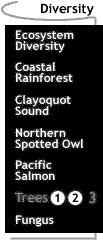

  |
Diversity: Trees Forest Fragmentation Fragmentation of a habitat simply means breaking it into smaller, discontinuous pieces. This may result from either natural disturbance or human interaction. Whether forest fragmentation is caused by natural blow-downs or clear cutting by timber companies, it has a dramatic effect on the inhabitants of its ecosystem.
The health of the ecosystem depends on the interdependent relationships of the living organisms within it. These organisms are able to live within the ecosystem because environmental conditions in that particular ecosystem satisfy their survival needs. When changes occur within the ecosystem, these needs may no longer be met and the organisms either die out or relocate. One example of environmental change due to fragmentation is a rise in water temperature caused by an increase in the amount of sunlight that reaches the surface of a stream. Salmon, for instance, are very sensitive to water temperature and require cold, clear water. The western hemlock is an understory tree. It needs the shade and protection of larger trees such as, the Douglas fir or Sitka spruce in order to survive. Decreased food supply and increased exposure to predators are also examples of changes due to forest fragmentation. Large mammals such as the grizzly bear, require sizable, continuous territories in which to hunt. Evidence also indicates that survival rates for larger mammals are greater when human contact is minimal. The northern spotted owl needs the protection of continuous forest to avoid predators. Its worst enemy is another larger owl! Because it is a relatively small, slow-flying bird, it becomes more vulnerable to predators when flying across a wide clearing to another group of trees. Plants and animals live in areas that meet their needs. Major alteration of that habitat affects these living organisms in ways we are just beginning to understand (Carstensen,1996). Pioneer Plants Pioneer plants specialize in living in places that have been severely disturbed by fire, wind storms, clear cutting, or other types of logging. Geographical areas have different pioneer plants, and most areas have more than one species that performs this role. In many areas of northwestern North America, the flowering plant called 'fireweed' is a pioneer plant. Not only is it one of the first plants into an area that has burned, but it can also be seen along the sides of newly bulldozed dirt roads. In southeast Alaska, spruce is the tree that pioneers a disturbed area. In Oregon and especially in Washington, the alder tree is a pioneer plant. During a period of 70-100 years, the alder routinely sheds its leaves each winter, slowly adding humus to the soil. The alder is one of several plants where the bacteria living on the fine tree roots take nitrogen from the air, fix (combine) it with oxygen, hydrogen, and other elements to form compounds used by plants for amino acid synthesis, and add the compounds to the soil. Over time, the pioneer plants change the chemical composition of the soil, its moisture retention, and shade conditions. On the one hand, this could be seen as soil improvement for the reemergence of the indigenous plants. On the other hand it could be seen as pollution in the sense that the pioneer plants eventually create conditions in which they can no longer live, though other plants flourish. In the ancient rainforests of the Northwest, wind is a major source of disturbance. It causes blowdowns of species of enormous shallow-rooted trees. Seeds of pioneer plants are carried into an area by wind and by animals such as birds, deer, and bears, and the process starts again. The bracken fern and wind-blown spores of mosses are the first plants to emerge after major disturbances, and if the process is allowed to continue, the western red cedar, Douglas fir, and hemlock will regrow. Pioneer plants are vital to the process of regrowth (Carstensen,1996).
[ Diversity: Ecosystem Diversity / Coastal Rainforest /
|
HTML code by Chris Kreger
Maintained by ETE Team
Last updated November 10, 2004
Some images © 2004 www.clipart.com
Privacy Statement and Copyright © 1997-2004 by Wheeling Jesuit University/NASA-supported Classroom of the Future. All rights reserved.
Center for Educational Technologies, Circuit Board/Apple graphic logo, and COTF Classroom of the Future logo are registered trademarks of Wheeling Jesuit University.